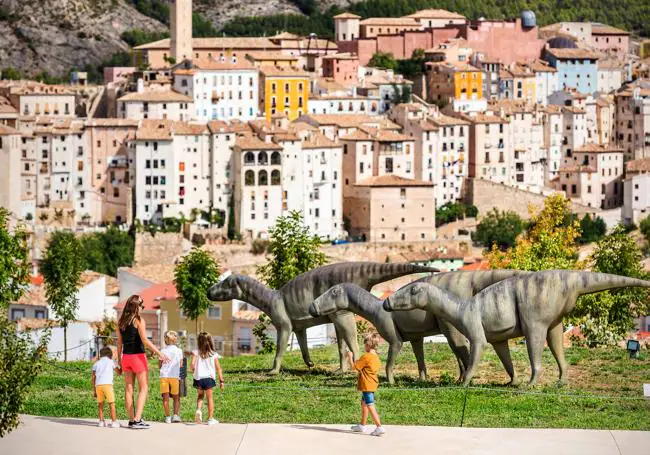Cuenca: a great secret hidden in Spain
Gastronomy Capital 2023 and World Heritage site, a dual-purpose trip in a unique environment
Galo Martín
Cuenca
Friday, 24 November 2023, 17:25
trip to Cuenca has two sides to it. On the one hand there is the city, a World Heritage site that brings you to relaxation through serene walks along its streets, alleys, and narrow passages that lead to the Plaza Mayor, the Cathedral and the Júcar river. Local restaurants line the streets turning local gastronomy into a form of art. Just like the abstract art exhibited in its museums, notable ones being the Science and Paleontology museums. Art is found everywhere, including in the form the engineering work of the houses that hand over the Júcar river. And on the other side of the river is an untouched, enchanted place of nature where the archaeological sites tell us about its past dwellers.
The city
The Cathedral of Cuenca is a series of complex architectural structures built throughout many centuries, allowing visitors to envision different artistic styles of each era. Its original architectural style was gothic, which has been preserved in some parts such as the ribbed vault ceiling design and the triforium gallery. The city’s Museum of Abstract Art hosts the Casas Colgadas (Hanging Houses), both unique and hypnotising. Visitors will also find an exhibition of paintings and sculptures by Spanish abstract artists from the fifties and sixties who shaped Spanish art trends throughout the mid-twentieth century.

A visit to this museum can be topped off with the Roberto Polo Collection and the Antonio Perez foundation. Within the old town, in the Plaza de la Merced, is the Science Museum of Castilla-La Mancha. A space that consists of two buildings which are divided into several parts: Astronomy and the Planetarium, the Time Machine, Treasures of the Earth, History of the Future and the Laboratory of life. Outside the city centre is the Paleontology Museum of Castilla-La Mancha. A visit to this museum takes you through the last 550 million years of earth’s history.
The heart of the collection is made up of old paleontological sites Las Hoyas (from the Early Cretaceous age) and Lo Huelco (from the Late Cretaceous age), although the rest of the paleontological sites in the region are also part of the collection. A visit to this museum is not complete without doing the Ruta de los Dinosaurios.
The province
Outside its city limits, the province of Cuenca is also very rich in culture and heritage. Its great attraction is the Serranía de Cuenca Nature Park. A place with great flora, fauna, water features and geology, for example the ‘Tormagales’ that look like magical cities constructed by fairies and elves, ‘Los Callejones’ or the ‘Enchanted City’ of Valdecabras, which has been declared a Natural Site of National Interest; and not forgetting the gorges and canyons naturally formed by the Júcar and Escabas rivers.

El Hosquillo is a a hunting park where species are bred for sustainable hunting, creating an environment where bears, wolves, mountain goats, deer, wild boars, as well as vultures and eagle owls can live in conditions similar to their natural environment. As for places of archaeological interest, the Yacimiento de Noheda is important to note, a Roman villa from between the 1st Century BC and the 6th century AD, as well as the Archaeological Park of Segóbriga, where you can see the aqueduct, the necropolis, the city, the theatre, the wall and the main gate, the forum, the baths, the basilica, the acropolis, the ampitheatre, the circus, and much more. Visiting this place allows you to really immerse yourself in the roots of an empire in the middle of La Mancha, a real adventure.
Good food and drink
Its cuisine and wines earned Cuenca the title of Spanish Capital of Gastronomy 2023
Like its geography, food from Cuenca is varied. Local recpies include morteruelo, ajo arriero, chorizos, zarajos, lamb, partridges, trout, cheeses y alajú. A special mention also has to be made to the excellent local wines and liqueurs: Resoli and Aguardiente de la Sierra. A cuisine and winery that has earned Cuenca the title of Spanish Capital of Gastronomy 2023.
This highly rated gastronomy and wine from Cuenca has ambassadors who advertise them to the rest of their world, boasting their restaurant’s Soles awarded by Repsol, the Spanish version of Michelin stars. Some of these ambassadors are: Jesús Segura, from the Casas Colgadas restaurant, which offers a unique tasting menu largely consisting of dishes based on sauces and creams using local products but with a modern twist. Miguel Escutia, from the Raff San Pedro restaurant, in Cuenca’s old town , where the menu takes you on a journey through the region’s history through its recipes, smells, flavours, textures and memories. Olga García and Álex Paz, from the Fuentelgato restaurant, in Huerta del Marquesado, an oasis that gives the Serranía de Cuenca’s gastronomic power a renewed power.
